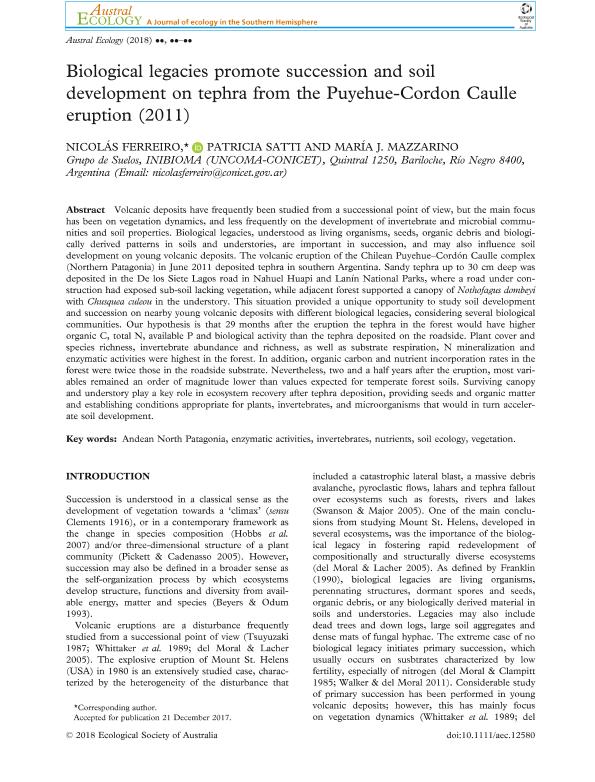Artículo
Biological legacies promote succession and soil development on tephra from the Puyehue-Cordon Caulle eruption (2011)
Fecha de publicación:
06/06/2018
Editorial:
Wiley Blackwell Publishing, Inc
Revista:
Austral Ecology
ISSN:
1442-9985
Idioma:
Inglés
Tipo de recurso:
Artículo publicado
Clasificación temática:
Resumen
Volcanic deposits have frequently been studied from a successional point of view, but the main focus has been on vegetation dynamics, and less frequently on the development of invertebrate and microbial communities and soil properties. Biological legacies, understood as living organisms, seeds, organic debris and biologically derived patterns in soils and understories, are important in succession, and may also influence soil development on young volcanic deposits. The volcanic eruption of the Chilean Puyehue–Cordón Caulle complex (Northern Patagonia) in June 2011 deposited tephra in southern Argentina. Sandy tephra up to 30 cm deep was deposited in the De los Siete Lagos road in Nahuel Huapi and Lanín National Parks, where a road under construction had exposed sub-soil lacking vegetation, while adjacent forest supported a canopy of Nothofagus dombeyi with Chusquea culeou in the understory. This situation provided a unique opportunity to study soil development and succession on nearby young volcanic deposits with different biological legacies, considering several biological communities. Our hypothesis is that 29 months after the eruption the tephra in the forest would have higher organic C, total N, available P and biological activity than the tephra deposited on the roadside. Plant cover and species richness, invertebrate abundance and richness, as well as substrate respiration, N mineralization and enzymatic activities were highest in the forest. In addition, organic carbon and nutrient incorporation rates in the forest were twice those in the roadside substrate. Nevertheless, two and a half years after the eruption, most variables remained an order of magnitude lower than values expected for temperate forest soils. Surviving canopy and understory play a key role in ecosystem recovery after tephra deposition, providing seeds and organic matter and establishing conditions appropriate for plants, invertebrates, and microorganisms that would in turn accelerate soil development.
Archivos asociados
Licencia
Identificadores
Colecciones
Articulos(INIBIOMA)
Articulos de INST. DE INVEST.EN BIODIVERSIDAD Y MEDIOAMBIENTE
Articulos de INST. DE INVEST.EN BIODIVERSIDAD Y MEDIOAMBIENTE
Citación
Ferreiro, Nicolas Andres; Satti, Patricia; Mazzarino, Maria Julia; Biological legacies promote succession and soil development on tephra from the Puyehue-Cordon Caulle eruption (2011); Wiley Blackwell Publishing, Inc; Austral Ecology; 43; 4; 6-6-2018; 435-446
Compartir
Altmétricas




